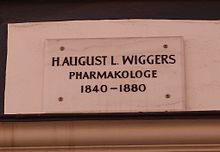August Wiggers
Heinrich Ludwig August Wiggers (born June 12, 1803 in Altenhagen, Springe , † February 13, 1880 in Göttingen ) was a German pharmacologist and botanist. Its official botanical author's abbreviation is “ A.Wigg. "
Wiggers had been a pharmacist since 1816 and was active in this profession until 1826 when he became assistant to Friedrich Stromeyer and his successor Friedrich Wöhler at the chemical laboratory of the University of Göttingen . In 1835 he received his doctorate in Göttingen and in 1837 he completed his habilitation, after which he was a private lecturer. In 1848 he became associate professor for pharmacy in Göttingen and in 1864 medical advisor. From 1836 to 1850 he was first deputy and later full general inspector of pharmacies in the Kingdom of Hanover. In 1860 he also became inspector general of the pharmacies in the Principality of Lippe.
He undertook chemical investigations of the mineral springs of Bald Wildungen, Bad Pyrmont and Driburg.
In Göttingen he set up a pharmacognostic collection of medicinal plants, which had 5,000 specimens when he died. His main work is a handbook of pharmacognosy, which deals with poisonous and medicinal plants and pharmaceutical agents from the animal kingdom and among minerals.
Fonts
- Inquisitio in secale cornutum respectu inprimis habito ad ejus ortum, naturam 1831 (price publication in Göttingen)
- Inquisitio in fungum medullarem chemica, in AA Muehry: Ad parasitorum malignorum inprimis ad fungi medullaris oculi historiam symbolae aliquot, 1833
- The separation and testing of mineral poisons from suspicious organic substances with regard to hydrogen cyanide and opium, 1836
- Floor plan of Pharmacognosie 1840, 5th edition 1864 (as handbook of Pharmacognosie), digital version of the 1847 edition, Bayerische Staatsbibliothek
literature
- Julius Pagel: Wiggers, Heinrich August Ludwig . In: Allgemeine Deutsche Biographie (ADB). Volume 42, Duncker & Humblot, Leipzig 1897, p. 465.
References and comments
| personal data | |
|---|---|
| SURNAME | Wiggers, August |
| ALTERNATIVE NAMES | Wiggers, Heinrich Ludwig August (full name) |
| BRIEF DESCRIPTION | German pharmacologist and botanist |
| DATE OF BIRTH | June 12, 1803 |
| PLACE OF BIRTH | Jump |
| DATE OF DEATH | February 13, 1880 |
| Place of death | Goettingen |
